The Corsair Carbide 600Q Case Review: Upside Down But Right On
by E. Fylladitakis on September 12, 2016 8:30 AM EST- Posted in
- Cases/Cooling/PSUs
- Corsair
- ATX
- E-ATX
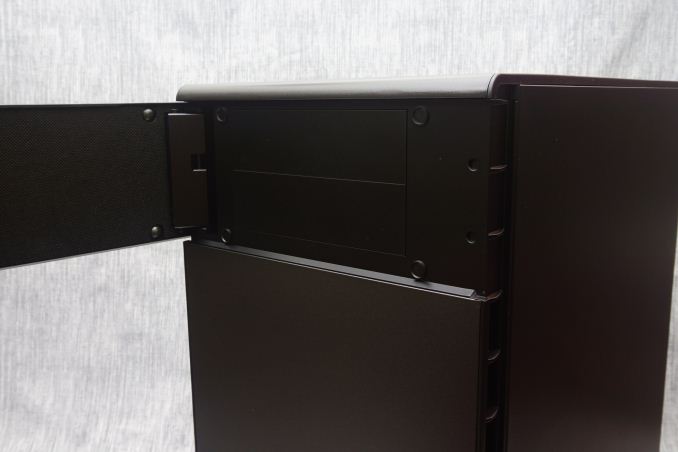
The concept of reversed and rotated motherboard tray cases is not new. Such designs primarily received attention with the introduction of the BTX form factor, when manufacturers were trying to make their products both ATX and BTX compatible. The prime example is probably the first generation Cooler Master Stacker, both for its design and what followed. The Stacker was successful enough to spawn a whole family of cases, however none of them retained the original's reversable tray. And, as things turned out, that's an accurate reflection of the larger market: ever since the BTX form factor has been abandoned, there are very few cases with rotated and reversed motherboard trays. Those few cases that still offer alterable trays are considered unordinary, special designs.
Introduction
It is just such a special case that we are taking a look at in this review: the Corsair Carbide 600Q Inverse ATX case. Corsair introduced the Carbide 600Q as a high quality product that is focused on utility and low-noise operation. The primary attraction of this case however is its interior design. As the name suggests, the Carbide 600Q has an inversed motherboard tray that, according to the company, should enhance the thermal performance of the system. It goes without saying then that we'll be paying special attention to that claim for this review, and seeing how it compares against typical ATX designs.
| Corsair Carbide 600Q | ||
| Motherboard Size | EATX, ATX, Micro-ATX, Mini-ITX | |
| Drive Bays | External | 2 × 5.25" |
| Internal | 2 × 3.5" 3 × 2.5" |
|
| Cooling | Front | 2 × 120 mm or 2 x 140 mm (2 × 140 mm included) |
| Rear | 1 × 140 mm (included) | |
| Top | - | |
| HDD | - | |
| Bottom | 3 × 120 mm or 2 x 140 mm (not included) | |
| Radiator Support | Front | Up to 280 mm |
| Rear | Up to 140 mm | |
| Top | - | |
| Side | - | |
| Bottom | Up to 360 mm | |
| I/O Port | 2× USB 3.0, 2× USB 2.0, 1× Headphone, 1× Mic | |
| Power Supply Size | ATX | |
| Clearances | HSF | 200 mm |
| PSU | 210 mm | |
| GPU | 370 mm | |
| Dimensions | 535 mm × 260 mm × 454 mm 21.06 in × 10.24 in × 17.87 in |
|
| Prominent Features | · Inverse ATX Layout: With this new layout, airflow is directed at the hottest devices in your system; the GPU and CPU, and not wasted on drive cages. · (Windowed Version Only): Full side panel window: A gorgeous, panoramic full side panel window shows off your components, and the tool-free latch and hinge lets you get in and out of the case easily. · Steel Exterior: Get rid of those plastic cases - the 600C has full steel front and top panels for extra durability and good looks. · Three included AF140L fans: Great airflow doesn't have to be noisy. The AF140L fans can push good amounts of air across your hottest devices with less distracting fan hum, and the three-speed fan controller lets you decide exactly how fast they run. · PSU and 5.25" Bay Cover: Clean up the inside of your case by tucking all those cables and less-attractive drives behind a clean, refined PSU and 5.25" bay cover. Or remove them for assembly - it's up to you. · Water-cooling Ready: Fit up to a 280mm radiator up front and up to a 360mm radiator on the bottom - along with the 140mm rear fan mount, that means your next build can be both cool and beautiful. · Easy to Clean: Easy-access dust filters on the front and bottom mean you'll never spend more than a minute getting dust out of your system. · Easy to Build: Tool-free drive installation, side panel access, and tons of cable routing options and tie downs means you can spend less time building your PC and more time using it. |
|
| Price | $140 | |
Packaging & Bundle
Corsair supplies the Carbide 600Q in a monochromic and aesthetically simple, but very sturdy cardboard box. The case is well protected inside it by two thick Styrofoam slabs and a nylon bag.
The company kept the main bundle of the case down to the basics. Only the necessary black mounting hardware, a manual and a few short cable ties are supplied alongside with the 600Q.
By default, the case has two 140 mm fans installed. A third 140 mm fan however is supplied along with the case, packed along with its mounting screws and a thank you note inside a small box. The user can decide the mounting location of this 140 mm fan, or choose not to install it at all in favor of lower noise levels.


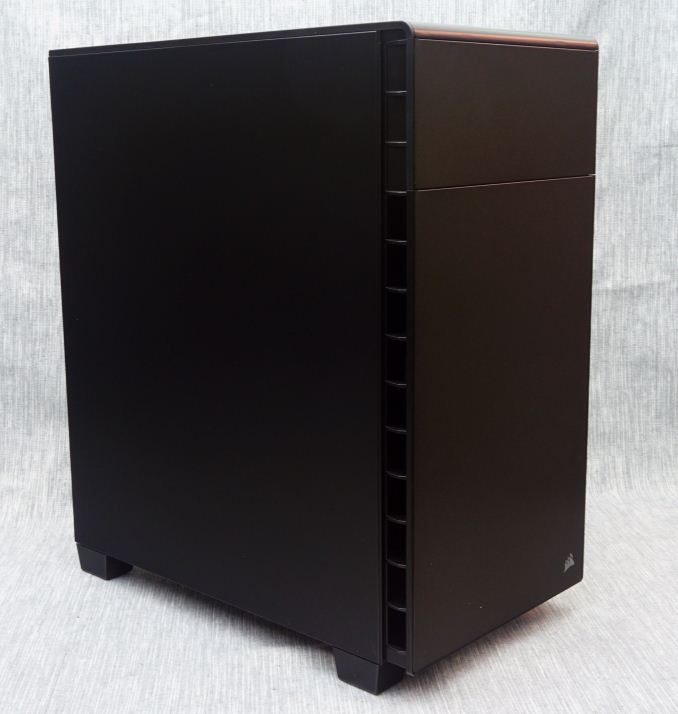
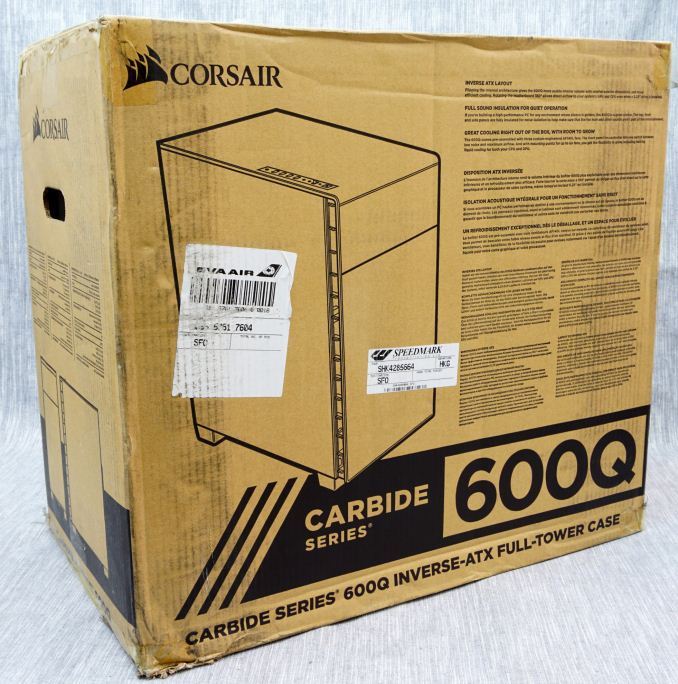
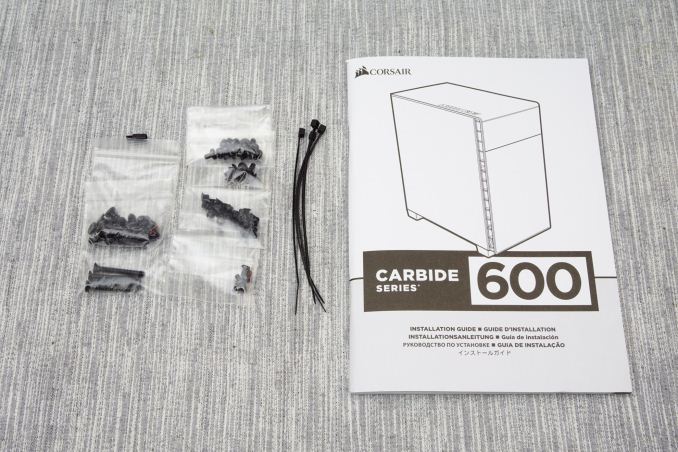
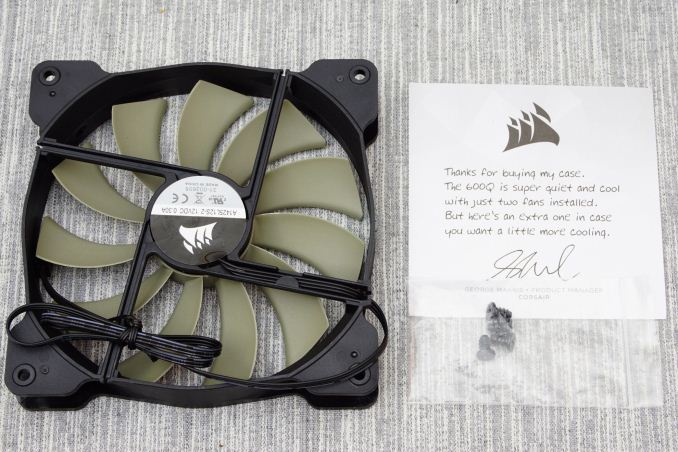








46 Comments
View All Comments
User.Name - Monday, September 12, 2016 - link
I'm not in the "I love my FT02" camp, but I do wish they would update the FT02 as well - or that their patent on 90° rotated motherboards would expire so that other manufacturers could use the design.• Despite the 180mm fan below them, that thing is a hot box for hard drives with an awful plastic mounting system, and there's no ventilation for the SSD mount. It can only hold five 3.5" drives too, which is not many for a case this size.
• If you have optical drives, they can interfere with the PCIe slots and would block airflow from the HDDs if there was any ventilation up there. (yes, I'm apparently a dinosaur now with my need for 2+ optical drives and many HDDs)
• It's a pain having to remove/install the top cover to access the cables. It should be a double-hinged "door" that can open from either side, which can optionally be removed.
• Cleaning the dust filters requires you to remove the top cover and the side panel to gain access. Dust filters should be removable from the front or the side of any case, so that you don't have to move it.
• Despite its huge exterior size (and weight), I actually found the case quite cramped and awkward to build in. Cable management seemed like an afterthought. Remember when high-end cases had removable motherboard trays?
I'm looking to build a new PC in the near future, and struggling to find a good alternative case though. With the size and weight of modern GPUs, I really don't like the idea of one of them hanging unsupported from a PCIe slot.
Azurael - Monday, September 12, 2016 - link
I prefer my PSU to be breathing cool air from outside the case. It's also one less variable to consider when trying to build a positive pressure set-up to minimise dust intake.Lolimaster - Tuesday, September 13, 2016 - link
Actually the PSU works with cooler temps at the bottom (heat goes from bottom to top, so in a top mounted setup, the PSU easy the heat from the mobo, cpu, hdd's and gpu)Spunjji - Tuesday, September 13, 2016 - link
The PSU moving to the bottom was a trend started by silence enthusiasts. You don't get all the warm air in the PC blowing through your PSU, which makes it run cooler and quieter and more efficiently. Having it at the top is a bad idea.seamonkey79 - Monday, September 12, 2016 - link
Read - "I'm young enough to computers to only remember bottom mounted cases."Icehawk - Monday, September 12, 2016 - link
Yup, it is only recently that PSUs are bottom mounted, it used to be a novelty.I have never seen a top mounted machine that was unstable so not really a concern.
IMO orientation all depends on what hardware you will be using.
I wish they would ditch 5" bays, I haven't populated one in 6+ years, they could make atx cases a good bit smaller then.
Ancillas - Monday, September 12, 2016 - link
I thought the same thing, until I put water cooling components into my mid-size. That's why the space is still there on so many cases, just with modular drive bays.If you're not doing water cooling, then yeah, free up that space!
Murloc - Tuesday, September 13, 2016 - link
I remember that even only 10 years ago bottom mounted PSUs weren't a given so how can that beDanNeely - Monday, September 12, 2016 - link
Isn't it amusing the way designs go full circle. Taking advantage of a top PSU + 5.25 bay section and not putting horizontal 3.5" HDDs in front of the mobo isn't new either. My parents circa 2000 Compaq mini tower did the same (although it put the HDD vertical against the front panel).OTOH I'm surprised it took as long as it did to go back to this orientation since it's the most compact way to support a second 5.25 bay for anyone who wants then (a single bay can share space with top fan mounts) while otherwise making the case compact front to back by removing the big HDD cages from the front.
Impulses - Monday, September 12, 2016 - link
Yeah... And this whole business of center of gravity - huh? Biggest selling point for bottom mounted PSU as I remember it originally was moving them away from the hottest component (CPU), but then that shifted to become the GPUs (at least under load)...Course this case doesn't really change that but still. The Silverstone TJ06 had an identical design to this, over ten years ago, when bottom mounted PSU were just starting to become trendy. Only deterrence was a larger top compartment with more bays.